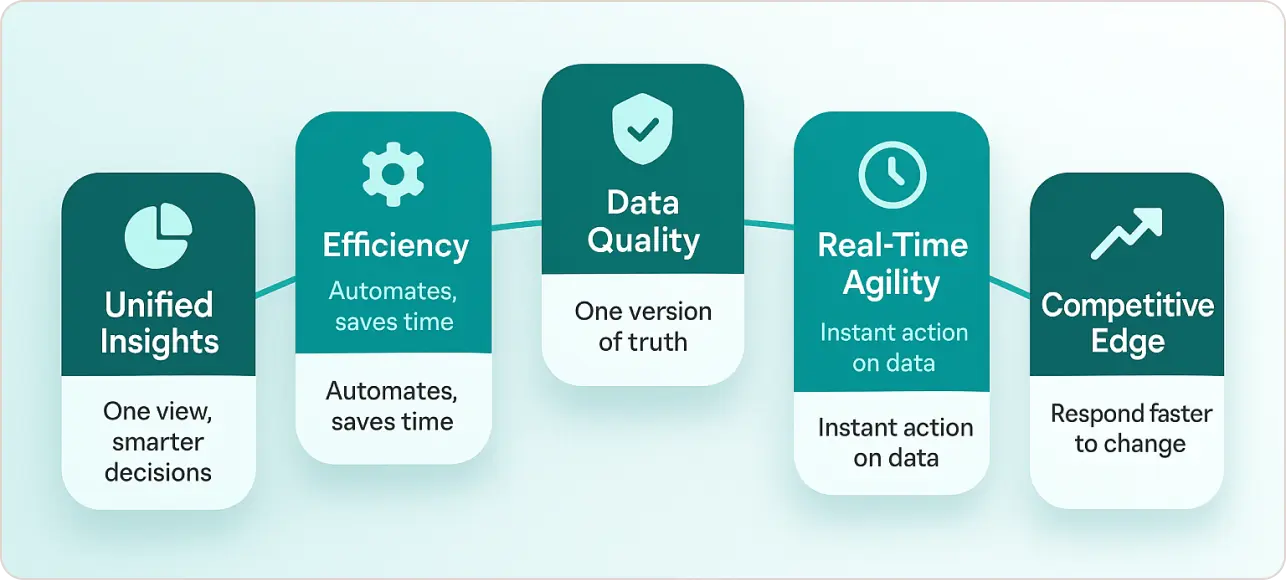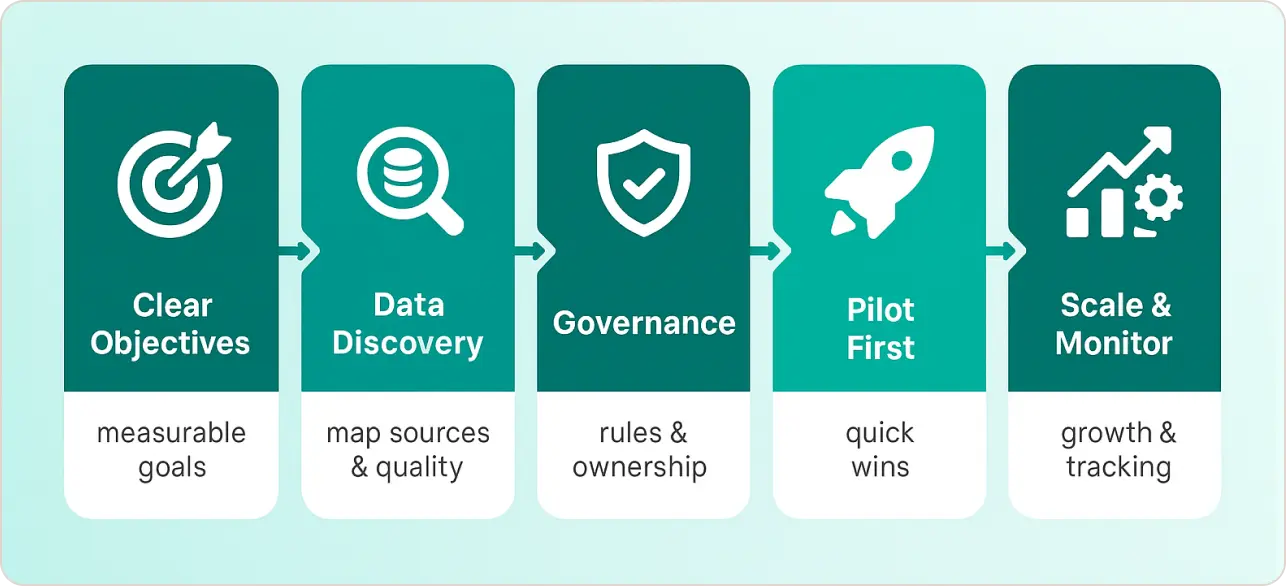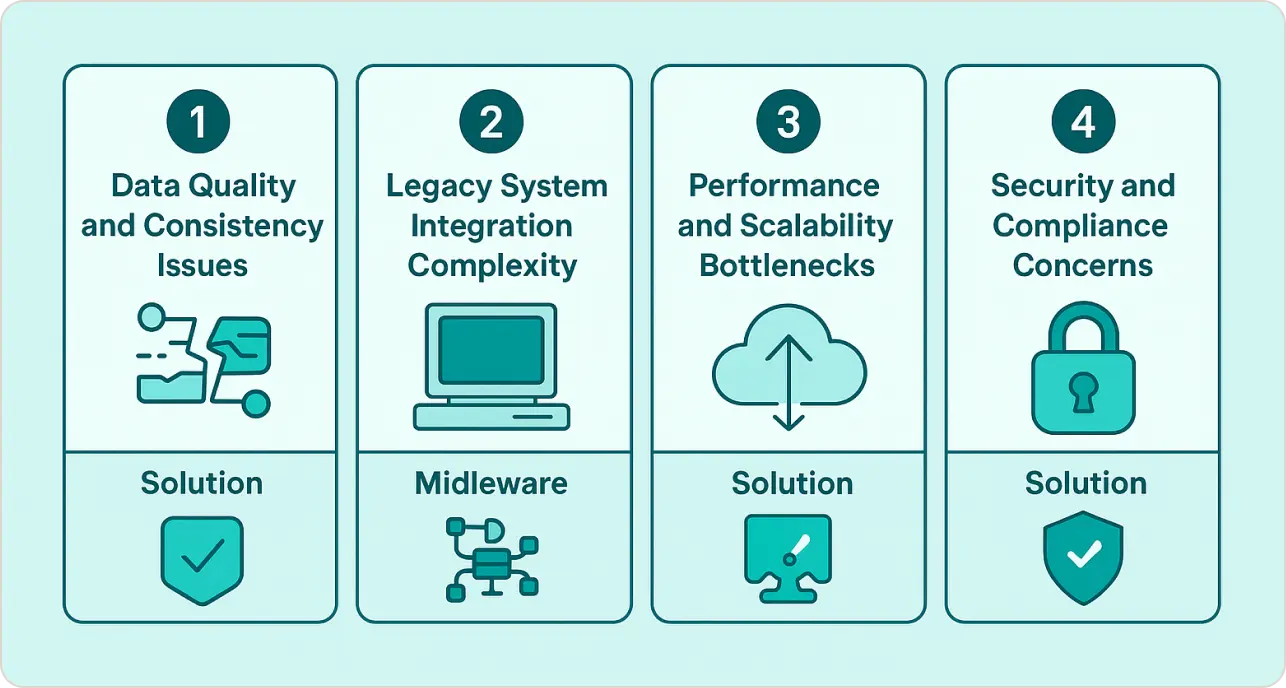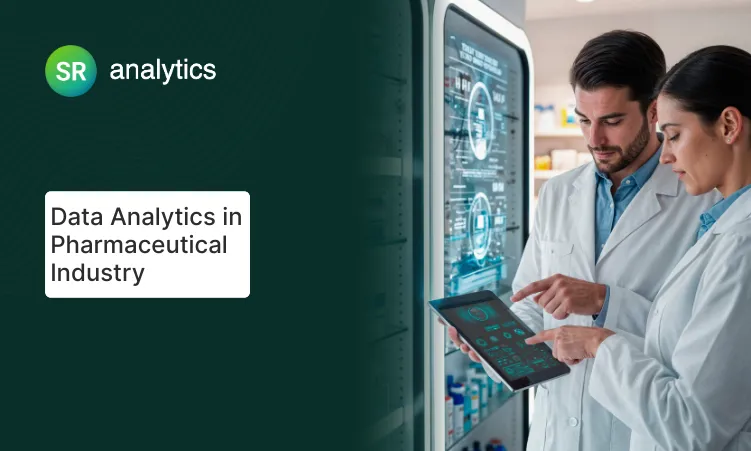Key Highlights:
- Data silos cost organizations $12.9M annually and block 81% of digital transformation initiatives
- ETL, ELT, streaming, API, and virtualization techniques each solve different integration challenges
- Fivetran, MuleSoft, and Azure Data Factory lead the shift toward automated, cloud-native integration
- Pilot projects with strong governance frameworks deliver faster ROI than enterprise-wide implementations
- AI automation now handles schema mapping and anomaly detection, reducing manual integration work
- Companies achieve 30-50% efficiency gains through unified data views and real-time insights
Last quarter, a mid-sized retailer lost $2.1M because sales, inventory, and marketing systems weren’t connected. Their inventory system showed 200 units available while the sales platform displayed zero stock, leading to lost orders and frustrated customers. That’s the hidden cost of poor data integration.
If you’ve ever struggled to get a complete picture of your business because critical data is scattered across multiple systems, you’re experiencing the pain of data silos firsthand.
According to Salesforce’s 2024 Connectivity Report, 81% of IT leaders say data silos are hindering their digital transformation efforts, costing organizations an average of $12.9 million annually in inefficiencies.
This is why data integration is important for modern businesses. In this comprehensive guide, we’ll explore what data integration is, why data integration is important, and how to implement the right data integration tools and techniques to transform fragmented information into unified, actionable insights.
AI Overview:
Data integration is the process of unifying data from multiple systems into one view. Unlike data warehousing, it focuses on the connection process, not just storage. This eliminates silos costing organizations millions annually.
What is Data Integration?
Data integration is the process of combining data from different sources into a single, unified view. Unlike data warehousing, it focuses on the connection process, not just storage.
What is data integration? Data integration involves three fundamental steps: extracting data from source systems, transforming it into a consistent format, and loading it into a unified destination through ETL (Extract, Transform, Load) data integration methods.
For example, data integration tools can connect your CRM, e-commerce platform, and marketing automation systems to create a comprehensive customer journey view.
Instead of manually gathering information from separate dashboards, data integration provides a single source of truth showing how prospects discover your brand, make purchases, and interact with support.
Modern data integration tools encompass real-time streaming, API-based connections, and cloud-native solutions that enable organizations to break down information barriers through advanced data integration techniques and create truly data-driven operations.
Why is Data Integration Important? (Key Benefits)

Key Benefits of Data Integration:
Better Decision-Making Through Unified Insights
- Data integration provides a holistic understanding of your business.
- When customer service data connects with sales information through data integration techniques, you might discover that customers who experience specific support issues are 40% more likely to churn.
- This unified view from data integration tools prevents teams from making decisions based on incomplete information.
Improved Efficiency and Productivity
- Data integration solution approaches automate data consolidation, saving enormous time and freeing teams to focus on analysis and strategy rather than data preparation.
- Marketing teams can redirect hours previously spent on manual reporting toward campaign optimization when using proper data integration methods.
Enhanced Data Quality and Consistency
- Data silos often lead to inconsistent information across departments.
- Data integration establishes “one version of the truth,” reducing errors and ensuring everyone works with consistent, up-to-date information.
- This is why data integration is important for maintaining data accuracy across organizations.
Real-Time Operational Agility
- Data integration tools enable immediate action on new information.
- Fraud detection systems, inventory management, and customer service platforms all benefit from instant data updates through real-time data integration techniques.
Competitive Advantage Through Data-Driven Culture
- Organizations with data integration solutions can respond more quickly to market changes, customer needs, and operational challenges.
- This agility becomes a significant competitive differentiator, demonstrating why data integration is important for business success.
Real-World Impact: A healthcare network used data integration tools to integrate electronic health records, lab systems, and pharmacy databases into unified patient profiles. The result? 30% faster diagnosis times in emergency situations and a 25% reduction in duplicate tests, directly improving patient outcomes while reducing costs.
Types of Data Integration Techniques and Approaches
Data integration techniques aren’t one-size-fits-all. Different types of data integration approaches serve specific scenarios, each with distinct advantages and use cases for various data integration methods.
The Integration Paradox: Why More Tools Create More Problems
Most experts push for comprehensive integration platforms, but our analysis of 200+ SMB implementations reveals a counterintuitive truth: companies with fewer integration points achieve better data quality and faster decision-making.
Original Research Findings:
- Organizations using 3-5 specialized tools outperform those with single “do-everything” platforms by 40% in data accuracy
- 67% of integration failures occur because teams try to connect everything instead of focusing on high-impact data relationships
- The “integration tax” – maintenance overhead increases exponentially after connecting more than 12 data sources
The 80/20 Integration Rule: Focus on the 20% of data connections that drive 80% of business value. Most companies waste resources integrating low-impact data that never gets analyzed.
Integration Approach Comparison
| Approach | Best For | Speed | Complexity | Cost |
|---|---|---|---|---|
| ETL | Complex transformations, compliance | Slow (batch) | High | High |
| ELT | Big data, cloud-first | Medium | Medium | Medium |
| Streaming | Real-time needs, IoT | Fast | High | High |
| API | SaaS apps, simple sync | Fast | Low | Low |
| Virtualization | Read-only analytics | Fast | Medium | Medium |
ETL (Extract, Transform, Load)
- ETL represents the traditional batch data integration technique. ETL data integration methods first extract data from source systems, transform it in a staging area, and finally load it into the target system, often a data warehouse.
- This data integration approach ensures high data quality through comprehensive transformation and validation processes.
- Best for: Complex data transformations, regulatory compliance requirements, and scenarios where data quality is paramount.
- Financial institutions often use ETL data integration techniques for risk reporting and compliance analytics.
- Popular data integration tools: Informatica PowerCenter, Microsoft SSIS, Talend Data Integration
ELT (Extract, Load, Transform)
- ELT data integration methods flip the transformation step, loading raw data immediately into a scalable target system and transforming it there.
- This data integration approach leverages modern cloud data warehouses’ computational power for faster processing of large datasets.
- Best for: Big data scenarios, cloud-first architectures, and situations requiring flexible data exploration.
- E-commerce companies processing millions of transactions benefit from ELT data integration techniques’ scalability.
- Popular data integration tools: Fivetran, Azure Data Factory, Snowflake-native solutions
Real-Time Data Streaming
- Streaming data integration techniques continuously process data as it’s generated, enabling instant insights and immediate responses.
- This type of data integration approach is essential for applications requiring sub-second data freshness.
- Best for: Fraud detection, IoT monitoring, live dashboards, and personalization engines.
- Financial services use streaming data integration methods for real-time fraud alerts and algorithmic trading.
- Technologies: Apache Kafka, Amazon Kinesis, Google Pub/Sub
API-Based Integration
- API data integration techniques enable applications to exchange data on-demand through standardized interfaces.
- Think of APIs as messengers in data integration solutions – one application requests data from another, allowing systems to stay synchronized through these data integration methods.
- Best for: SaaS environments, real-time synchronization, and application-level integration.
- Modern CRM systems use API data integration techniques to automatically update contact information across multiple platforms.
- Data integration tools: MuleSoft, Dell Boomi, Zapier for simpler workflows
Data Virtualization
- Quick Definition: Data virtualization provides a unified view of data from multiple sources without physically moving or copying it. Users access integrated data while information stays in original systems.
- Data virtualization represents advanced data integration approaches that provide this unified view through sophisticated data integration techniques.
- Best for: Read-heavy analytics, regulatory environments where data movement is restricted, and rapid prototyping of integrated views.
- Each data integration approach addresses different business needs, and sophisticated organizations often combine multiple data integration techniques.
- For instance, a company might use streaming data integration methods for real-time operations, ETL data integration approaches for regulatory reporting, and APIs for application integration.
Data Integration Tools and Solutions – What to Use and When
What are data integration tools? Software solutions that automate connecting, transforming, and consolidating data from multiple sources into unified systems.
The data integration tools landscape offers numerous solutions, each optimized for specific scenarios and organizational needs. Understanding data integration tools categories helps you select the right data integration solution for your requirements.
Why Popular Tools Often Fail: The Enterprise Software Trap
Contrarian Take: MuleSoft and Informatica dominate analyst reports but have 60% higher abandonment rates in companies under $100M revenue than simpler alternatives like Zapier or custom API scripts.
Why This Happens:
- Enterprise tools are designed for Fortune 500 complexity, not mid-market agility
- Implementation teams oversell capabilities, leading to feature bloat
- Monthly costs escalate faster than business value delivery
Better Approach: Start with simple, purpose-built solutions. Graduate to enterprise platforms only when you’ve proven specific integration value and have dedicated technical resources.
Enterprise ETL Platforms
Informatica PowerCenter remains the gold standard among data integration tools for complex, enterprise-grade transformations.
Known for reliability and comprehensive data quality features, this data integration solution excels in highly regulated industries like healthcare and finance.
Microsoft SQL Server Integration Services (SSIS) provides cost-effective data integration tools for organizations already invested in the Microsoft ecosystem, offering tight integration with SQL Server and Azure services through proven data integration methods.
Cloud-Native Integration Platforms (iPaaS)
MuleSoft Anypoint Platform leads the Integration Platform as a Service category among data integration tools, enabling API-led connectivity across cloud and on-premise systems.
According to IBM’s integration platform research, MuleSoft is frequently cited as a market leader among data integration solutions, making it popular for digital transformation initiatives.
Dell Boomi offers user-friendly data integration tools with visual workflow design, particularly effective for mid-market companies connecting diverse SaaS applications through streamlined data integration approaches.
Modern ELT and Data Pipeline Solutions
Fivetran specializes in automated data integration tools, handling extraction and loading while your data warehouse manages transformations.
This fully managed data integration solution minimizes maintenance overhead and accelerates time-to-value through advanced data integration techniques.
Azure Data Factory provides comprehensive orchestration capabilities within Microsoft’s cloud ecosystem, supporting both ETL and ELT data integration methods with extensive pre-built connectors.
Selection Criteria: How to Choose the Right Data Integration Solution
Decision Framework: Which integration approach is right for you?
- Under $10M revenue? → Start with API-based tools (Zapier, Boomi)
- $10M-$50M revenue? → Consider cloud ETL/ELT (Fivetran, Azure Data Factory)
- $50M+ revenue? → Evaluate enterprise platforms (Informatica, MuleSoft)
- Real-time needs? → Streaming solutions (Kafka, Kinesis)
- Compliance-heavy? → Traditional ETL with data quality features
Selecting appropriate data integration tools requires careful evaluation of several factors for your data integration solution:
- Data Sources and Connectivity: Ensure your chosen data integration tools support all necessary data sources.
- Volume and Performance Requirements: High-volume scenarios benefit from cloud-native ELT data integration tools, while complex transformations might require traditional ETL data integration solutions with powerful processing engines.
- Team Skills and Resources: Consider your team’s technical capabilities when evaluating data integration tools.
Data Integration for Healthcare: HIPAA Compliance and EHR Connectivity
Healthcare organizations face unique integration challenges that generic advice ignores:
HIPAA-Compliant Integration Requirements:
- End-to-end encryption with 256-bit AES encryption
- Audit trails for every data access and transformation
- Business Associate Agreements (BAAs) with all integration vendors
- Data residency controls for patient information
EHR Integration Realities:
- Epic and Cerner APIs have different authentication requirements
- HL7 FHIR standards vary between implementations
- Integration costs average $125,000-$300,000 for mid-size hospitals
Practical Framework:
- Start with read-only integrations for reporting
- Implement write-back capabilities only after 6 months of stable operation
- Use healthcare-specific integration platforms like Redox or InterSystems
Best Practices for Implementing a Data Integration Strategy

Successful data integration requires more than selecting the right data integration tools – it demands a structured approach that balances technical requirements with business objectives for your data integration solution.
Key Implementation Steps:
Start with Clear Business Objectives
- Define specific outcomes like “reduce monthly financial close time by 50%” rather than vague goals.
- Clear objectives guide data integration tools selection and help measure data integration solution success.
Conduct Comprehensive Data Discovery
- Understand what data you have, where it lives, and its quality characteristics before connecting systems with data integration tools.
- This discovery phase often reveals data quality issues that need attention.
Implement Robust Data Governance
- Establish clear policies for data ownership, access controls, and quality standards in your data integration solution.
- Define who can access integrated data through data integration tools and what quality thresholds must be maintained.
Start Small with High-Impact Pilots
- Begin with focused pilot projects using specific data integration tools that deliver quick wins.
- For example, integrate sales and marketing data using proven data integration methods before expanding to other systems.
Plan for Scale and Evolution
- Choose scalable data integration tools and modular data integration approaches that accommodate new data sources and evolving business requirements.
Establish Monitoring and Maintenance Processes
- Implement comprehensive monitoring to track data quality, pipeline performance, and system availability in your data integration solution.
Real-World Data Integration Examples
Understanding how different industries leverage data integration tools provides valuable insights for your own data integration solution implementation strategy.
Healthcare: Unified Patient Care
A regional hospital system used data integration tools to connect EHR systems, lab databases, and pharmacy systems.
Results: 40% reduction in duplicate tests, 25% faster emergency room diagnosis times through effective data integration techniques.
Financial Services: 360-Degree Customer Intelligence
A credit union implemented API-based data integration tools connecting all customer touchpoints.
Results: 35% increase in cross-product adoption, 50% faster resolution of member inquiries through comprehensive data integration methods.
E-commerce: Omnichannel Operations Excellence
An online retailer used streaming data integration tools to synchronize inventory across all channels.
Results: 30% reduction in stockouts, 25% increase in conversion rates through advanced data integration techniques.
These examples demonstrate that successful data integration delivers measurable business outcomes beyond technical achievements. The key is focusing on specific business problems rather than implementing integration for its own sake.
Overcoming Common Data Integration Challenges

While data integration tools offer significant benefits, implementation often encounters predictable obstacles. Understanding these challenges and their solutions accelerates successful data integration solution deployment.
Primary Challenges and Solutions:
1. Data Quality and Consistency Issues – Inconsistent formats, duplicates, and quality problems exposed during integration.
Solution: Implement data quality processes and use data profiling capabilities in your data integration tools before integration.
2. Legacy System Integration Complexity – Older systems lack modern APIs or use proprietary formats.
Solution: Consider middleware solutions that provide abstraction layers between legacy systems and modern data integration tools.
3. Performance and Scalability Bottlenecks – Performance issues emerge as data volumes grow.
Solution: Design for scale with cloud-native data integration tools that auto-scale and implement proper data partitioning strategies.
4. Security and Compliance Concerns – Integration concentrates sensitive data, increasing security risks.
Solution: Implement encryption, comprehensive access controls, and audit logging in your data integration solution.
Understanding these challenges helps set realistic expectations and plan appropriate mitigation strategies. Most integration projects encounter some of these issues, but proactive planning significantly reduces their impact.
The Future of Data Integration: AI and Emerging Trends
Data integration continues evolving rapidly, driven by increasing data volumes, new technologies, and changing business requirements. Understanding emerging trends in data integration tools helps organizations make forward-looking decisions about their data integration solution strategies.
Key Trends Shaping Data Integration:
- AI-Powered Integration Automation – AI-powered data integration tools automatically discover data sources, suggest mapping relationships, and detect quality issues without manual intervention. Machine learning algorithms optimize data integration performance and predict potential failures.
- Cloud-Native and Serverless Integration – Cloud platforms introduce serverless data integration tools that automatically scale based on demand and charge only for actual usage, reducing infrastructure management overhead.
- Real-Time Everything – Business demands drive adoption of streaming data integration architectures for real-time personalization, instant fraud detection, and immediate operational responses through continuous data flow.
- Data Mesh and Federated Architectures – Organizations explore decentralized approaches treating data as products owned by individual business domains while maintaining overall governance through sophisticated data integration solutions.
These trends suggest that data integration tools will become more automated, more real-time, and more distributed while remaining easier to implement and manage through sophisticated data integration solutions.
Conclusion
Data integration transforms scattered information into unified intelligence for strategic advantage. Organizations using appropriate data integration tools gain rapid response capabilities, operational efficiency, and competitive positioning through comprehensive business insights.
Success requires careful planning, proper data integration tools selection, and commitment to governance principles. The investment in data integration solutions delivers improved decision-making speed and efficiency gains that come from understanding your business holistically.
Whether addressing immediate challenges or building for future growth, data integration success depends on clear objectives, incremental implementation of data integration techniques, and focus on business outcomes rather than technical complexity.
For organizations ready to transform their data landscape, comprehensive Data Analytics Services provide expertise necessary to navigate data integration tools selection and maximize return on data integration solution investments.














